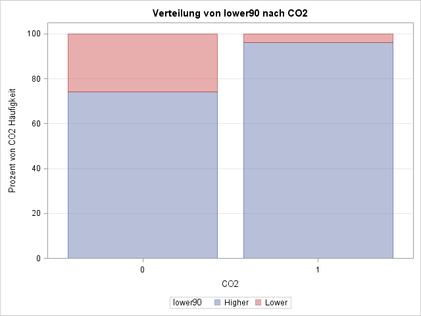- Home
- /
- Programming
- /
- Graphics
- /
- Create VBAR and HBAR with percentages of a continuos variable
- RSS Feed
- Mark Topic as New
- Mark Topic as Read
- Float this Topic for Current User
- Bookmark
- Subscribe
- Mute
- Printer Friendly Page
- Mark as New
- Bookmark
- Subscribe
- Mute
- RSS Feed
- Permalink
- Report Inappropriate Content
Hallo!
I would need some help to create a Graph with my data.
The dataset looks like this:
data have;
input ID $ co2 $ area area_under area_over;
datalines;
101 High 329274.45563 1161.4533333 328113.0023
101 Low 329807.07976 51867.348667 277939.7311
103 High 299940.79867 1437.205 298503.59367
103 Low 309707.27464 196061.47517 113645.79948
105 High 500296.11766 32079.163619 468216.95404
105 Low 330042.631 69774.392944 260268.23805;
Run;and the graphS I would like to obtain like this:
N.1
where I have two vBars (one for every co2 level) and the blue part rapresent the percentage area_over/area and the red part rapresent the percentage area_under/area.
If possible I would also like to have a standard deviation bar.
N.2
The second Graph I would like to have looks like this
Thank you very much for your help!
Riccardo
Accepted Solutions
- Mark as New
- Bookmark
- Subscribe
- Mute
- RSS Feed
- Permalink
- Report Inappropriate Content
Try the following and see if they meet your needs:
data have;
input ID $ co2 $ area area_under area_over;
datalines;
101 High 329274.45563 1161.4533333 328113.0023
101 Low 329807.07976 51867.348667 277939.7311
103 High 299940.79867 1437.205 298503.59367
103 Low 309707.27464 196061.47517 113645.79948
105 High 500296.11766 32079.163619 468216.95404
105 Low 330042.631 69774.392944 260268.23805
;
Run;
data have_neg;
set have;
area_under = -1 * area_under;
run;
proc format;
proc format;
picture posval low-high='000,009';
run;
proc sgplot data=have;
yaxis label="Area";
vbar co2 / response=area_under stat=mean limitstat=stddev discreteoffset=-0.2 barwidth=0.4;
vbar co2 / response=area_over stat=mean limitstat=stddev discreteoffset=0.2 barwidth=0.4;
run;
proc sgplot data=have_neg;
format area_under posval.;
xaxis label="Area";
hbar co2 / response=area_under stat=mean;
hbar co2 / response=area_over stat=mean;
run;Hope this helps!
Dan
- Mark as New
- Bookmark
- Subscribe
- Mute
- RSS Feed
- Permalink
- Report Inappropriate Content
Where do the 0 and 1 come from for the first graph???
It looks like as at least one step you need something like:
data have; input ID $ co2 $ area area_under area_over; under = area_under/area; over = area_over /area; datalines; 101 High 329274.45563 1161.4533333 328113.0023 101 Low 329807.07976 51867.348667 277939.7311 103 High 299940.79867 1437.205 298503.59367 103 Low 309707.27464 196061.47517 113645.79948 105 High 500296.11766 32079.163619 468216.95404 105 Low 330042.631 69774.392944 260268.23805 ; Run;
(Note: the semicolon to end a datalines block must be after the last line of data)
Or perhaps you intend to sum the area, area_under and area_over and then do the percentages. But I can't tell which.
- Mark as New
- Bookmark
- Subscribe
- Mute
- RSS Feed
- Permalink
- Report Inappropriate Content
Try the following and see if they meet your needs:
data have;
input ID $ co2 $ area area_under area_over;
datalines;
101 High 329274.45563 1161.4533333 328113.0023
101 Low 329807.07976 51867.348667 277939.7311
103 High 299940.79867 1437.205 298503.59367
103 Low 309707.27464 196061.47517 113645.79948
105 High 500296.11766 32079.163619 468216.95404
105 Low 330042.631 69774.392944 260268.23805
;
Run;
data have_neg;
set have;
area_under = -1 * area_under;
run;
proc format;
proc format;
picture posval low-high='000,009';
run;
proc sgplot data=have;
yaxis label="Area";
vbar co2 / response=area_under stat=mean limitstat=stddev discreteoffset=-0.2 barwidth=0.4;
vbar co2 / response=area_over stat=mean limitstat=stddev discreteoffset=0.2 barwidth=0.4;
run;
proc sgplot data=have_neg;
format area_under posval.;
xaxis label="Area";
hbar co2 / response=area_under stat=mean;
hbar co2 / response=area_over stat=mean;
run;Hope this helps!
Dan
April 27 – 30 | Gaylord Texan | Grapevine, Texas
Registration is open
Walk in ready to learn. Walk out ready to deliver. This is the data and AI conference you can't afford to miss.
Register now and lock in 2025 pricing—just $495!
Learn how use the CAT functions in SAS to join values from multiple variables into a single value.
Find more tutorials on the SAS Users YouTube channel.
SAS Training: Just a Click Away
Ready to level-up your skills? Choose your own adventure.





